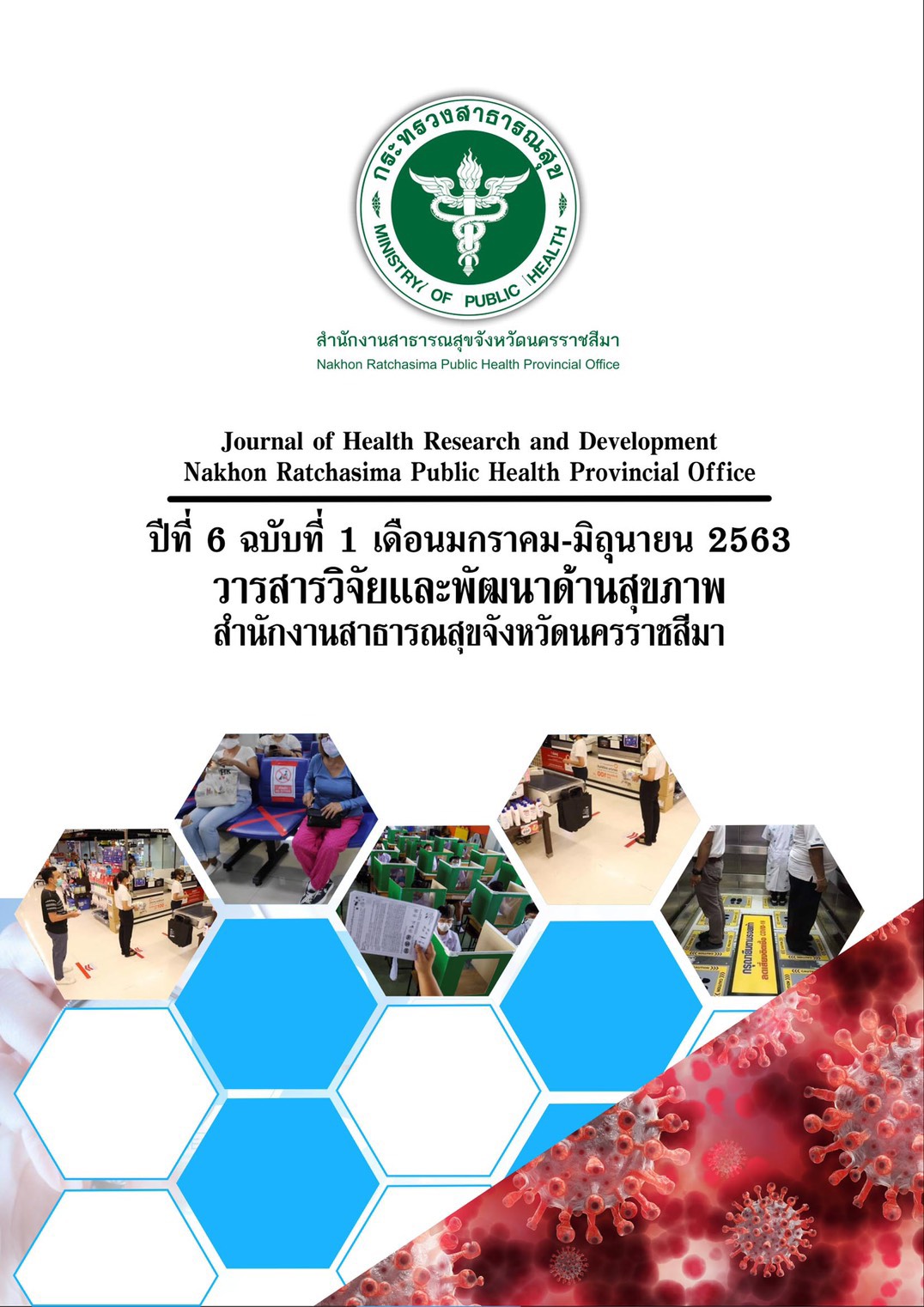การรับรู้ความสามารถของตนเองในการเผชิญการเจ็บครรภ์คลอด
คำสำคัญ:
การรับรู้ความสามารถของตนเอง, การเผชิญการเจ็บครรภ์คลอด, ผู้คลอดบทคัดย่อ
การรับรู้ความสามารถของตนเองเป็นแนวคิดที่สำคัญทางด้านทฤษฎีการเรียนรู้ทางสังคมปัญญาซึ่งส่งผลให้ผู้คลอดรับรู้ความสามารถของตนเองในการเผชิญการเจ็บครรภ์คลอด การรับรู้ความสามารถของผู้คลอดมีความสัมพันธ์กับทั้งสามปัจจัยหลักซึ่ง ประกอบด้วย ปัจจัยส่วนบุคคล ปัจจัยด้านสภาพแวดล้อม และปัจจัยด้านพฤติกรรม การศึกษานี้จะเป็นประโยชน์ต่อบุคคลากรทางด้านสุขภาพในการวางแผนการดูแลเพื่อที่จะส่งเสริมให้ผู้คลอดมีความมั่นใจในการเผชิญความเจ็บปวดจากการคลอดและนำไปสู่ผลลัพธ์ที่ดีของการคลอดต่อไป
เอกสารอ้างอิง
Lowe NK. Critical predictors of sensory and affective pain during four phases of labor. Journal of Psychosomatic Obstetrics & Gynecology 1991; 12 : 193 – 208.
Murray SS, McKinney ES. Foundations Of maternal-newborn and women’s health nursing (5thed.). St.Missouri: Elsevier Saunders; 2010.
Lowe NK. Self - efficacy for labor and childbirth fears in nulliparous pregnant women. Journal of Psychosomatic Obstetrics & Gynecology 2000; 21 : 219 – 24.
Sánchez-Cunqueiro MJ, Comeche MI, Docampo D. On the relation of selfefficacy and coping with the experience of childbirth. J Nurs Educ Pract 2018; 8(6) : 48 – 55.
Steen M. Understanding perineal pain: Women’s descriptions. British Journal of Midwifery 2008; 16(6) : 383 – 93.
ชญาภรณ์ เอกธรรมสุทธ์ิ และเกษร สุวิทยะ ศิริ. การพยาบาลในระยะคลอด. นนทบุรี: โครงการสวัสดิการวิชาการ สถาบันพระบรมราชชนก; 2560.
Melzack R, Wall PD. Pain mechanism: A new theory. Survay of anesthesia 1967; 11 (2) : 89 – 90.
Reynolds F. Labour analgesia and the baby: good new is no new. International Journal of Obstetric Anesthesia 2011; 20(1) : 38 – 58.
สุกัญญา ปริสัญญกุล และนันทพร แสนศิริพันธ์. การพยาบาลสตรีในระยะคลอดพิมพ์ ครั้งที่ 2. เชียงใหม่: โครงการตาราคณะพยาบาลศาสตร์ หาวิทยาลัยเชียงใหม่; 2553.
สุพิศ ศิริอรุณรัตน์ พิริยา ศุภศรี และรัชนี วรรณธอส. วิธีการเผชิญการเจ็บครรภ์คลอดของมารดาที่มีการคลอดครั้งแรก. วารสารคณะพยาบาลศาสตร์ มหาวิทยาลัยบูรพา 2557; 22(3) : 56 – 68.
Dick-Read J. The practice of natural childbirth. New York: Harper & Row; 1972.
Olah CM, Barry M. Antenatal stress: An Irish case study. American Journal of Epidemiology 2013; 157(1) : 14 – 24.
McKinney ES, James SR, Murray SS, et al. Maternal child nursing (4thed.). St.Louis: Saunders; 2013.
Bandura A. Self-efficacy: The exercise of control. New York: Freeman; 1997.
Lowe NK. Maternal confidence for labor : Development of the childbirth self - efficacy inventory. Research in Nursing & Health 1993; 16 : 141 – 9.
ศิริวรรณ ยืนยง และนันท์ภัส รักไทย. ผลของการสนับสนุนในระยะคลอดจากญาติใกล้ชิดต่อความเจ็บปวดความวิตกกังวลและความพึงพอใจต่อประสบการณ์การคลอดของมารดาครรภ์แรก. วารสารคณะพยาบาลศาสตร์ มหาวิทยาลัยบูรพา 2554; 19(2) : 67 – 82.
Larsson C, Saltvedt S, Edman G, et al. Factors independently related to a Negative birth experience in first - time mothers. Sexual & Reproductive Healthcare 2011; 2(2) : 83 – 9.
Allport GW. Reading in attitude theory and measurement. New York: John Welley and Sons; 1968.
มาลีวัล เลิศสาครศิริ. ต้นทุนชีวิต ครอบครัวเข้มแข็ง และเจตคติต่อการตั้งครรภ์กับพฤติกรรมการดูแลสุขภาพของหญิงตั้งครรภ์วัยรุ่ น (รายงานผลการวิจัย). กรุงเทพฯ: วิทยาลัยเซนต์หลุยส์; 2556.
Kundu A, Ghose A. The relationship between attitude and self - efficacy in mathematics among higher secondary students. Journal of Humanities and Social Science; 2016; 21(4) : 25 – 31.
Recber S, Isiksal M, Koc Y. Investigating Self - efficacy, anxiety, attitudes and mathematics achievement regarding gender and school type. Anales de Psychology 2018; 34(1) : 41 – 51.
กวินฑรา ปรีสงค์. ปัจจัยที่มีความสัมพันธ์กับพฤติกรรมการดูแลตนเองของหญิง ตั้งครรภ์ที่มารับบริการฝากครรภ์โรงพยาบาลบางนา 5 จังหวัดสมุทรปราการ. วารสารร่มพฤกษ์ มหาวิทยาลัยเกริก 2558; 33(3) : 116 – 36.
นนั ทพร แสนศิริพันธ์. ความกลัวการคลอดบุตร. พยาบาลสาร 2556; 40 : 103 – 12.
Asayesh H, Hosseini AM, Sharififard F, et al. The relationship between self –efficacy and test anxiety among the paramedical students of Qom University of Medical Sciences. Journal of Advances in Medical Education 2016; 1(3): 14 – 21.
Barrows J, Dunn S, Lloyd AC. Anxiety, Self - efficacy, and college exam grades. Universal Journal of Educational Research 2013; 1(3): 204 – 08.
Razavi AS, Shahrabi A, Siamian H. The relationship between research anxiety and self-efficacy. Materia Soci-medica 2017; 29(4) : 247 – 50.
Tahmassian K, Moghadam JN. Relationship between self - efficacy and symptoms of anxiety, depression, worry, and social avoidance in a normal sample of students. Iran Journal of Psychiatry and Behavioral Sciences 2011; 5(2) : 91 – 8.
Haines HM, Rubertsson C, Pallant JF, et al. The influence of women’s fear, attitudes and beliefs of childbirth on mode and experience of birth. BMC Pregnancy and Childbirth 2012; 12(1) : 1 – 14.
Rastegari L, Mohebbi P, Mazlomzadeh S. The effect of childbirth preparation training classes on perceived self- efficacy in delivery of pregnant women. Zanjan Univ Med Sci. 2013; 21(86) : 105 – 15.
House JS. Work stress and social support. Reading, MA: Addison-Wesley; 1981.
Schwartz L, Toohill J, Creedy DK, et al. Factors associated with childbirth self efficacy in Australian childbearing women. BMC Pregnancy and childbirth 2015; 15(1) : 1 – 9.
ปาณิสรา ไชยวงศา สร้อย อนุสรณ์ และธรีกุล วิชัยอึงพินิจพงศ์. ผลของการกดจุดต่อความรู้สึกเจ็บครรภ์ของผู้คลอดครรภ์แรก ในระยะที่หนึ่งของการคลอด. วารสารพยาบาลศาสตร์และสุขภาพ 2552; 31(4) : 38 – 47.
Cunningham FG, Leveno KJ, Bloom SL, et al. Williams Obstetrics. (23rded.). United States of America: McGraw-Hill; 2010.
จันทนา โปรยเงิน ศิริวรรณ แสงอินทร์ และวรรณทนา ศุภสีมานนท์. ผลของโปรแกรม การส่งเสริมความสามารถของตนเองในการคลอด ต่อการรับรู้ความสามารถของตนเองในการคลอดและการควบคุมตนเองระหว่างการคลอดของผู้คลอดครรภ์แรก. วารสารคณะพยาบาลศาสตร์ มหาวิทยาลยั บูรพา 2558; 23(1) : 1 – 12.
ปาริฉัตร อารยะจารุ เยาวลักษณ์ เสรีเสถียร ฉวีวรรณ อยู่สาราญ และคณะ. ผลของโปรแกรมการให้ความรู้ต่อความวิตกกังวลระดับความเจ็บปวดและพฤติกรรมการเผชิญความเจ็บปวดในระยะคลอด ของมารดาวัยรุ่นครรภ์แรก. วารสารสภาการพยาบาล 2013; 27(4): 96 – 108 .
หญิง แท่นรัตน์ พิริยา ศุภศรี และวรรณทนา ศุภสีมานนท์. ผลของโปรแกรมส่งเสริมการเผชิญการเจ็บครรภ์คลอด ต่อคะแนนความเจ็บปวดและการรับรู้ประสบการณ์การคลอดของผู้คลอดครั้งแรก. วารสารวิทยาลัยพยาบาลบรมราชชนนี กรุงเทพ 2560; 33(2) : 64 – 72.
สุภัสสรา ภูเมฆ ปรียาวรรณ วิบูลย์วงศ์.บทบาทสามีในการดูแลภรรยาในระยะคลอด. วารสารวิทยาลัยพยาบาลบรมราชชนนี กรุงเทพ 2560; 33(3) : 166 – 77.
ดาวน์โหลด
เผยแพร่แล้ว
รูปแบบการอ้างอิง
ฉบับ
ประเภทบทความ
สัญญาอนุญาต
บทความที่ได้รับการตีพิมพ์เป็นลิขสิทธิ์ของสำนักงานสาธารณสุขจังหวัดนครราชสีมา กระทรวงสาธารณสุข
ข้อความที่ปรากฏในบทความแต่ละเรื่องในวารสารวิชาการเล่มนี้เป็นความคิดเห็นส่วนตัวของผู้เขียนแต่ละท่านไม่เกี่ยวข้องกับสำนักงานสาธารณสุขจังหวัดนครราชสีมา และบุคลากรท่านอื่นๆในสำนักงานฯ แต่อย่างใด ความรับผิดชอบองค์ประกอบทั้งหมดของบทความแต่ละเรื่องเป็นของผู้เขียนแต่ละท่าน หากมีความผิดพลาดใดๆ ผู้เขียนแต่ละท่านจะรับผิดชอบบทความของตนเองแต่ผู้เดียว



